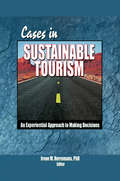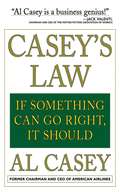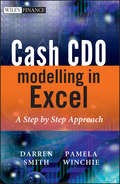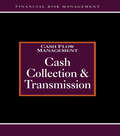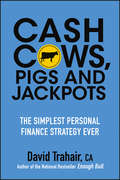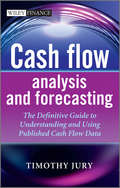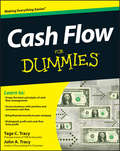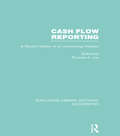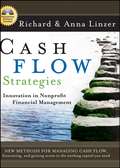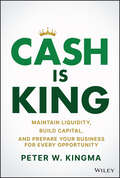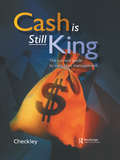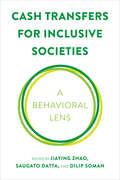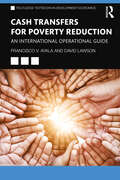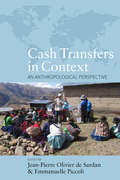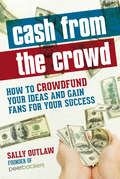- Table View
- List View
Cases in Sustainable Tourism: An Experiential Approach to Making Decisions
by Kaye ChongMake sure your students are prepared for the difficult decisions they&’ll face every day in the tourism industryCases in Sustainable Tourism is a groundbreaking teaching tool that places students in real-life situations where they&’re faced with complex decisions on the economic, social, and environmental sustainability of act
Casey's Law: If Something Can Go Right, It Should
by Al CaseyMurphy's Law tells us that if something can go wrong, it will. Al Casey tells us: If things can go right, they should. But you've got to make them go right by working hard. One of the most successful-and original-American businessmen of our time, Al Casey was a no- nonsense turnaround specialist who, if offered a choice of two or more jobs, always chose the more most challenging. He transformed places as diverse as American Airlines and the United States Post Office into successful giants. Here, with great wit and charm, he offers practical advice on where and how American business needs to focus if it is to maintain its position as global leader in the twenty-first century.
Cash CDO Modelling in Excel
by Darren Smith Pamela WinchieThis book is an introduction to the modelling of cash collateralised debt obligations ("CDOs"). It is intended that the reader have a basic understanding of CDOs and a basic working knowledge of Microsoft Office Excel. There will be written explanations of concepts along with understandable mathematical explanations and examples provided in Excel. A CD-ROM containing these Excel examples will accompany the book.
Cash Collections Transmission: Cashflow Management (Risk Management Ser.)
by Alistair GrahamFirst Published in 2000. Routledge is an imprint of Taylor & Francis, an informa company.
Cash Cows, Pigs and Jackpots: The Simplest Personal Finance Strategy Ever
by David TrahairA contrarian and controversial look at personal finance, and a super simple strategy for making—and keeping—more money Traditional financial wisdom persuades us to grow our net worth and build our assets. But traditional financial wisdom is often wrong. In Cash Cows, Pigs and Jackpots: The Simplest Personal Finance Strategy You'll Ever See, author and Chartered Accountant David Trahair challenges everything we think we know about managing our money, suggesting that that we follow the lead of the financial institutions that are leading us down the path to financial ruin. The banks, brokers, and investment companies of the world make enormous sums of money because they know that cash is king and they know how to guarantee cash flow from their clients on a continual basis. They aren't making the bulk of their money from investing in the stock market—they're leeching it from regular people like you, every minute of every day. Cash Cows, Pigs and Jackpots turns the tables, showing that the biggest cash cow we have is ourselves. Instead of chasing a dream that will never come true, it presents a financial plan so simple even a 10-year-old could understand it. Explains why the common consensus about making money is inherently flawed Presents an incredibly simple, easy-to-follow plan for really making and saving money Exposes the dangers of trusting money to a bank or broker Helping you break asset addiction, get out of debt, and increase your personal cash flow—and your wealth with it, Cash Cows, Pigs and Jackpots explains how bringing more cash into your life and watching carefully where it goes will allow you to save more, live the life you want, and avoid as much risk as possible—a great strategy going into the stormy financial years to come
Cash Flow Analysis and Forecasting: The Definitive Guide to Understanding and Using Published Cash Flow Data (The Wiley Finance Series #653)
by Timothy JuryThis book is the definitive guide to cash flow statement analysis and forecasting. It takes the reader from an introduction about how cash flows move within a business, through to a detailed review of the contents of a cash flow statement. This is followed by detailed guidance on how to restate cash flows into a template format. The book shows how to use the template to analyse the data from start up, growth, mature and declining companies, and those using US GAAP and IAS reporting. The book includes real world examples from such companies as Black and Decker (US), Fiat (Italy) and Tesco (UK). A section on cash flow forecasting includes full coverage of spreadsheet risk and good practice. Complete with chapters of particular interest to those involved in credit markets as lenders or counter-parties, those running businesses and those in equity investing, this book is the definitive guide to understanding and interpreting cash flow data.
Cash Flow For Dummies
by John A. Tracy Tage TracyThe fast and easy way to grasp cash flow managementCash Flow For Dummies offers small business owners, accountants, prospective entrepreneurs, and others responsible for cash management an informational manual to cash flow basics and proven success strategies. Cash Flow For Dummies is an essential guide to effective strategies that will make your business more appealing on the market. Loaded with valuable tips and techniques, it teaches individuals and companies the ins and outs of maximizing cash flow, the fundamentals of cash management, and how it affects the quality of a company's earnings. Cash flow is the movement of cash into or out of a business, project, or financial product. It is usually measured during a specified, finite period of time, and can be used to measure rates of return, actual liquidity, real profits, and to evaluate the quality of investments. Cash Flow For Dummies gives you an understanding of the basic principles of cash management and its core principles to facilitate small business success.Covers how to read cash flow statementsIllustrates how cash balances are analyzed and monitored--including internal controls over cash receipts and disbursements, plus bank account reconciliation and activity analysisTips on how to avoid the pitfalls of granting credit--evaluating customer credit, sources of credit information, and overall credit policyAdvice on how to prevent fraud and wasteCovers cash-generating tactics when doing business with dot-coms, other start-ups, and bankrupt customersCash Flow For Dummies is an easy-to-understand guide that covers all of these essentials for success and more.
Cash Flow Reporting: A Recent History of an Accounting Practice (Routledge Library Editions: Accounting)
by Thomas A. LeeThis collection explores Kuhn’s 1970 perception of a scientific revolution in the form of a cyclical sequence of anomaly recognition; insecurity, alternative ideas, schools of thought and dominating practices. Cash flow reporting has become a dominant accounting practice which emerged from a developmental process of Kuhnian form. The text is constructed around the various stages identified by Kuhn and selected readings are categorised accordingly.
Cash Flow Strategies
by Richard S. Linzer Anna O. LinzerCash Flow Strategies offers nonprofit organizations an innovative approach to financial management. In this companion to The Cash Flow Solution, the authors, Richard and Anna Linzer, reveal their approach--which emphasizes the use of cash flow concepts that enable an organization to have the working capital it needs. The book is filled with illustrative examples and includes the tools and templates needed to make these concepts immediately applicable to any institution.Note: CD-ROM/DVD and other supplementary materials are not included as part of eBook file.
Cash Flow and the Time Value of Money
by Sherman C. Frey Jr.With the use of charts and examples, gives a detailed description of cash flows, the time value of money, and discounted cash flow analysis.
Cash In on the Learning: Realizing the Benefits of Enterprise Architecture
by Jeanne W. Ross Peter Weill David C. RobertsonThis chapter explains how companies get unique benefits at each of the four stages of enterprise architecture maturity by implementing different management practices and roles at each stage to formalize organizational learning.
Cash Is King: Maintain Liquidity, Build Capital, and Prepare Your Business for Every Opportunity
by Peter W. KingmaAn illuminating exploration of the importance of your company's cash position and the steps you can take to ensure organizational liquidity In Cash is King, working capital and cash strategist Peter W. Kingma delivers an insightful and practical discussion of why your company's cash position should be on an equal footing with sales, cost, and service, and how to make that happen. You'll learn why cash is the fuel in your corporate engine and discover the attributes of an organizational cash culture and how to adopt them within your own firm. While explaining some of the most important—and most misunderstood—corporate finance concepts, this book is not a finance textbook. Instead, it uses case study examples to offer concrete suggestions for improvements in your company that increase the availability of cash when you most need it. You'll also find: Discussions of the importance of sufficient liquidity for operational concerns, research and development, and capital improvements Explorations of the consequences of insufficient cash positions Examinations of the ripple effects of seemingly small decisions that affect cash supply An essential resource for managers, executives, and business leaders everywhere, Cash is King is an effective and hands-on exploration of cash as the lifeblood of any modern commercial entity and an incisive guide to ensuring that your company will have enough of it when its required.
Cash Is King: Your Working Capital Model--Why Thinking Strategically about Cash Flow Is Key to the Long-Term Success of Your Business
by Randy Komisar John MullinsThink working capital isn't important to your business? Think again. It doesn't matter how clever your products or how keen your customers, if you haven't got working capital on hand, you'll be out of business in the blink of an eye. Some savvy entrepreneurs have sharply reduced the gross margins they need by developing working capital models that have disrupted their industries. Could you be the disrupter that does this to your industry? Or are you at risk of having this done to you? As you'll see in this chapter, working capital models form the foundation for some of today's most interesting and revolutionary business models--like Dow Jones and Costco, both profiled here. The authors demonstrate why a seemingly innocuous concept like working capital is so important and why thinking strategically about cash and cash flow is the key to keeping your business moving. This chapter was originally published as Chapter 6 of "Getting to Plan B: Breaking Through to a Better Business Model."
Cash Is Still King: The Survival Guide To Cash Flow Management
by Keith CheckleyNothing provides a clearer picture of the financial strength (or weakness) of any business than an understanding of its cash flow strategy. Since cash is the life-blood of any business, the strength of the enterprise is directly related to the quality of its cash flow management strategies.Cash-management specialist Keith Checkley has consulted with and trained cash management specialists throughout the world. He brings the reader up to date on the important issues and essential techniques for implementing and managing an effective cash flow system. New case studies make the concepts easy to understand and apply.Cash Is Still King is divided into three parts: 1) cash flow and business management; 2) cash flow and banking relationships; and 3) cash flow and restructuring or reorganizing a business.
Cash Is a Reality Check: Cash Flow as a Critical Measure of Financial Health
by Karen Berman Joe KnightThe two most important measures for the entrepreneur who is just starting out are cash flow and burn rate (the amount of cash you burn through to operate in a given period, usually a month). Learning to keep a well-trained eye on both is key to building financial intelligence. This chapter is excerpted from "Financial Intelligence for Entrepreneurs: What You Really Need to Know About the Numbers."
Cash Management Practices in Small Companies
by Kevin Kelly H. Kent Bowen Laurence E. Katz Andrew R. Jassy Baltej KocharMost small business managers claim that cash management is their leading concern. Often walking a tightrope between growth and illiquidity, small business managers face different cash management challenges than their counterparts in larger companies. Compared to larger firms, small businesses often have under-staffed and under-trained accounting staffs, volatile cash flows dependent on a single product line, limited access to new capital, and a significant share of their net worth tied up in working capital. These limitations are often compounded by management's focus on growth, which can put additional pressure on the cash management system by increasing net working capital requirements.
Cash Transfers and Basic Social Protection
by Moritz Von GliszczynskiThe author offers a ground-breaking analysis of the political discourses that facilitated the rise of cash transfers as instruments of development policy since the 1990s. Using an innovative theoretical framework, von Gliszczynski gives a broad, yet detailed, overview of the history of basic social protection in global policy and identifies discursive shifts that radically changed the perception of cash transfers in global policy. His in-depth analysis of political discourses illustrates inhow far the career of cash transfers was part of a 'development revolution' and shows to what extent the ideas behind development policy have truly changed. By demonstrating that cash transfers are part of a specifically developmental model of social protection, this book also sheds light on potential future directions of social policy in the Global South.
Cash Transfers for Inclusive Societies: A Behavioral Lens (Behaviorally Informed Organizations)
by Dilip Soman Jiaying Zhao Saugato DattaThe latest title in the Behaviourally Informed Organizations series offers practical advice on how best to successfully design, deliver, and evaluate efficient cash transfer programs, with a view to alleviating poverty. While much progress has been made in reducing poverty worldwide – especially in the pre-pandemic era – it is fair to say that an unacceptably large proportion of the world’s people still live in poverty. Cash Transfers for Inclusive Societies sheds light on the widely prevalent cash transfer programs. The book asks these central questions: What is the state of the art in the development of welfare programs? What do we know works in these programs and what does not? How can an understanding of behavioral science better inform the design, delivery, and evaluation of welfare programs? The latest title in the Behaviourally Informed Organizations series, the book develops a nuanced framework for how governments, practitioners, and society in general should design cash transfer programs to improve inclusivity, reduce poverty, and improve equality. It draws on field experiments and case studies to showcase past successes, while also building frameworks and developing prescriptive advice that we can give to practitioners who are looking to design a behaviorally informed cash transfer program. With contributions from leading academics as well as seasoned practitioners, Cash Transfers for Inclusive Societies presents a new model to policymakers to study and shift the discourse on poverty alleviation from purely economic factors to also behavioral ones.
Cash Transfers for Poverty Reduction: An International Operational Guide (Routledge Textbooks in Development Economics)
by David Lawson Francisco V. AyalaOver the past 20 years, more than 100 countries have implemented social safety nets, targeted at the poorest and most vulnerable. Impact evaluations have shown the effectiveness of these programmes, and policymakers have explored different methods of delivery, including cash transfers. Cash Transfers for Poverty Reduction offers the first systematic discussion of the design and implementation of poverty reduction schemes, and cash transfer programmes in particular. The authors also draw on their own practical experienceand present global case studies to show the effects that these decisions have on operations and outcomes. Featuring end-of-chapter questions and answers to help test your knowledge, this book offers an operational guide for key stakeholders, officials and students in understanding the design, implementation, and monitoring and evaluation of cash transfer programmes.
Cash Transfers for Poverty Reduction: An International Operational Guide (Routledge Textbooks in Development Economics)
by David Lawson Francisco V. AyalaOver the past 20 years, more than 100 countries have implemented social safety nets, targeted at the poorest and most vulnerable. Impact evaluations have shown the effectiveness of these programmes, and policymakers have explored different methods of delivery, including cash transfers.Cash Transfers for Poverty Reduction offers the first systematic discussion of the design and implementation of poverty reduction schemes, and cash transfer programmes in particular. The authors also draw on their own practical experienceand present global case studies to show the effects that these decisions have on operations and outcomes. Featuring end-of-chapter questions and answers to help test your knowledge, this book offers an operational guide for key stakeholders, officials and students in understanding the design, implementation, and monitoring and evaluation of cash transfer programmes.
Cash Transfers in Context: An Anthropological Perspective
by Jean-Pierre Olivier de Sardan Emmanuelle PiccoliMarginal in status a decade ago, cash transfer programs have become the preferred channel for delivering emergency aid or tackling poverty in low-and middle-income countries. While these programs have had positive effects, they are typical of top-down development interventions in that they impose on local contexts standardized norms and procedures regarding conditionality, targeting, and delivery. This book sheds light on the crucial importance of these contexts and the many unpredicted consequences of cash transfer programs worldwide - detailing how the latter are used by actors to pursue their own strategies, and how external norms are reinterpreted, circumvented, and contested by local populations.
Cash Your Investment: How to Leverage Your College Degree into a Great First Job
by S. A. Eberwein“[Goes] into fine detail when it comes to networking, interviewing, and résumé building, which makes this book a worthwhile read for college graduates.” —University ChronicleAt last, your final year of college is here. Gone are the days of fretting about grades and filling up your free time with extracurricular activities; now it’s time to think about securing that perfect post-graduation job. It won’t be easy. In Cash Your Investment, S. A. Eberwein gives you the tools and guidance you need to bring the job you covet within reach.When he was a college undergraduate, Eberwein faced a steep learning curve in getting the attention of big-name employers. Through hard work and strategic study, however, he soon secured an enviable position with a prestigious company—in his case, a reputable investment banking firm in New York City. Now, he wants to teach you how to do the same.Cash Your Investment guides you toward your long-term job goals with original advice on job-search strategy, résumé writing, and interviews. Embark on your journey with a savvy plan and seek the job you’ve always dreamed about. Scour the landscape with an ambitious, multifaceted plan of attack, and be confident in your abilities. Keep at it, and don’t let early rejection get you down. S. A. Eberwein is proof, irrespective of your starting point, that you can convert your undergraduate degree into a stellar first job—Cash Your Investment shows you how.“A great and informative guide to help you through all your post-college struggles . . . a motivational and exciting read.” —The Bottom Line
Cash and Cash Traps: Making Innovation Pay
by John Butman Harold L. Sirkin James P. AndrewThis chapter discusses the paramount importance of cash payback and the key factors that affect it, introducing a tool that helps executives visualize, discuss, analyze, improve, and set goals for payback.
Cash from the Crowd
by Sally OutlawCROWDFUNDING-raising capital in small increments from a large number of people- will inject over $5 billion into the economy this year and is becoming a powerful way to fund new ideas and generate buzz for new products and ventures. Although crowdfunding has the potential to be an amazing boost to entrepreneurs, only 40% of projects succeed in reaching their funding goal. Crowdfunding platform founder Sally Outlaw reveals how entrepreneurs can shift these odds in their favor.Want to know which marketing efforts result in a 35% higher rate of contributions? OR, what is the best time and day to launch or promote a campaign? The answers to these and more are here.
